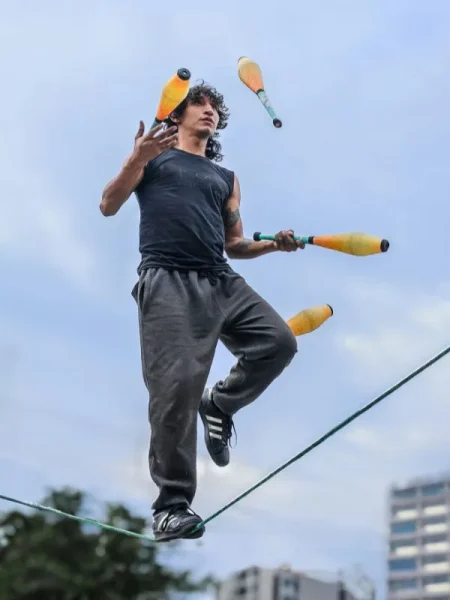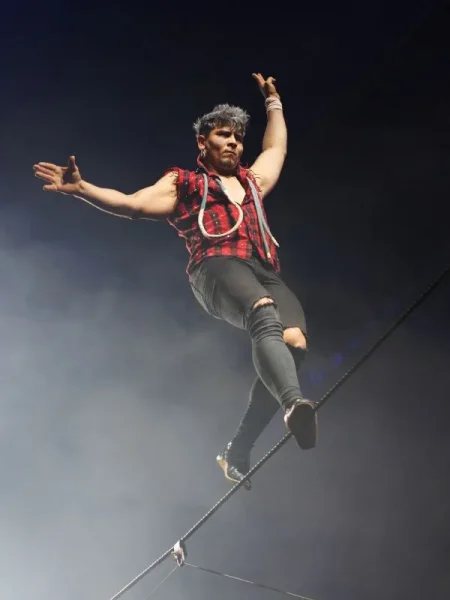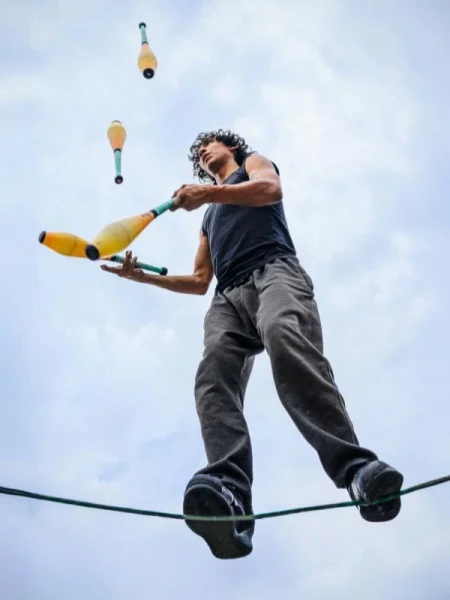Tightwire 101
Discover what tightwire is, gear check, beginner tips, brief history, where you can try it and more
What Is Tightwire, Really?
Let’s get this straight right off the bat – tightwire isn’t slackline.
Yes, both involve balancing on a wire or rope. But tightwire is stretched tight (hence the name), fixed from point A to point B, usually made of steel and often rigged a few feet – or several – off the ground. Slackline, on the other hand, has give. It wobbles. It bounces. Tightwire does not forgive that easily.
The goal with tightwire? Walk across. Stay up. Stay calm. Then, if you’re feeling brave, do it backwards. Or on one foot. Or juggling flaming clubs. (Kidding. Sort of.)
If you would like to learn more about slacklining, check out Slacklines 101.
Who Actually Walks on Wires?
It’s not just circus performers, though they’re the OGs. Think old-school tightrope walkers with balance poles and sequin-covered leotards. Those folks paved the way.
These days, tightwire shows up in all kinds of places:
– Circus schools: Training grounds for the next generation of performers.
– Theatre and live performance: For adding a little heart-pounding suspense.
– Street festivals and busking scenes: Portable rigs, big crowds, good energy.
– Personal practice: Some people just love the focus it demands.
It’s not as common as juggling or tumbling, but tightwire has a niche – one that pulls people in with its quiet intensity.
Gear Check: What You’re Working With
Let me walk you through the setup (pun… not totally intended):
– The wire: Usually steel cable, 3/8″ to 5/8″ thick. Tensioned tight – like a guitar string you could stand on.
– Rigging: Anchored at both ends, often to A-frame supports or towers.
– Walkway height: Can be a foot off the ground or far, far higher. For beginners, keep it low.
– Footwear: Split-soled acrobatic shoes or soft-soled sneakers. Some go barefoot for extra grip, though… ouch.
– Balance pole (optional): Long, weighted pole that lowers your center of gravity. It’s not cheating. It’s classic.
And yes, there’s usually a crash mat underneath – unless you’re performing at height, in which case you’ve trained to never fall.
The Goal Is Simple: Don’t Fall Off
But the reality? Way harder.
You’re not just trying to stay on the wire. You’re managing your breathing, micro-adjusting your hips and knees, keeping your eyes locked on the end point. Every tiny wobble feels exaggerated – because it is. The margin for error is razor-thin.
Let’s be honest: walking in a straight line on solid ground already takes subtle coordination. Now imagine doing that on something the width of your finger.
Your arms act like rudders. Your toes grip instinctively. And your brain? It’s on full alert – but in a strangely calm way, once you get used to it.



Beginner Tips That Actually Make a Difference
Here’s the thing. You don’t need to be an acrobat to get started. But you do need patience – and these basics:
– Eyes up: Look at the far end, not your feet. Your body follows your gaze.
– Relax the arms: Let them move freely, like wings.
– Bend your knees slightly: It gives you shock absorption and control.
– Take slow, intentional steps: No rushing. Feel the wire with your toes.
– Use your core: Not in a gym-bro way. Just be aware of it. It’s your anchor.
And here’s a fun contradiction: the more relaxed you are, the better your balance. But staying relaxed while standing on a wire? That’s the whole game.
What’s Happening in Your Brain?
Tightwire triggers this fascinating mix of panic and focus.
At first, everything screams “Get off! This isn’t safe!” Your fight-or-flight instincts kick in. Your heart races. Your muscles tense up.
But over time, your body recalibrates. You learn to read the wire’s tiny movements. Your brain maps out balance patterns. Eventually, it feels… not natural, exactly – but possible. And that’s when the real growth starts.
Balance becomes more than physical. It becomes mental. It sharpens your awareness. Clears your head. Grounds you.
Honestly? It’s kind of meditative. In a nerve-wracking, sweat-dripping, why-am-I-doing-this sort of way.
More Than Just Walking
Once you get the basics, things get interesting. There’s an entire vocabulary of movement on the wire – some subtle, some wild:
– Turns: Pivoting without falling is an art in itself.
– Backward walking: Trusting the wire behind you? Bold move.
– Kneeling or sitting: Requires as much strength as balance.
– Jumps and tricks: Only for the advanced – and fearless.
– Character movement: Some performers act, dance or even tell stories while balancing.
It’s not just about staying upright. It’s about owning the wire.
The Zen of Tightwire
People assume tightwire is about risk and adrenaline. And yeah, sure – that’s part of it. But many practitioners say it’s the stillness that draws them in.
When you’re on the wire, everything else fades. No distractions. No multitasking. Just step, breathe, adjust. It’s like walking meditation – with a physical edge.
And there’s something empowering about mastering fear in small doses. The wire teaches you how to fail safely – and keep going.
What Can Go Wrong?
A lot, honestly. That’s the fun part.
Wobbles: They happen. Correct early and you’ll be fine.
Overcorrecting: Too much movement just makes things worse.
Freezing mid-wire: You panic and your brain hits pause. Not helpful.
Looking down: Your feet don’t need your attention. The end point does.
Everyone falls at some point. That’s not failure – it’s feedback.
Where Did Tightwire Come From?
Tightwire’s been around forever, almost literally. There are records of tightrope walkers in Ancient Greece, China and Rome. Some performed for kings; others were street entertainers.
Over the centuries, it evolved. In 19th-century Europe, circus performers brought flair and height into the mix. Then came the legends: Charles Blondin crossing Niagara Falls, Philippe Petit walking between the Twin Towers. Highwire stunts grabbed headlines – but it all started with the same skill: just walking.
Tightwire Today: More Than a Sideshow
Right now, tightwire is having a quiet resurgence.
Circus schools around the world (like École Nationale de Cirque or The Circus Project) offer tightwire as a foundational discipline. It shows up in street festivals, contemporary dance, physical theatre. Some performers incorporate storytelling, live music or even spoken word.
Tightwire is evolving – but it hasn’t lost its core. One wire. One walker. A thousand tiny adjustments that somehow add up to grace.
Related Skills You’ll Accidentally Get Good At
You think you’re just learning to balance – but you’re actually training a whole toolkit:
– Core strength: Subtle, deep muscles get engaged in every step.
– Focus under pressure: Not just helpful on the wire, but, you know… life.
– Coordination: Every limb has to work together. No freeloaders.
– Spatial awareness: You become hyper-aware of body position and alignment.
– Composure: Staying calm when things go sideways? Huge life skill.
And maybe, just maybe, some self-confidence you didn’t know you needed.
So, Where Can You Try It?
Good news: you don’t need to join a circus. (Though… that would be cool.)
Try these:
– Circus training centers: Many offer intro classes. NECCA, SANCA, The Circus Center, just to name a few.
– Community circus groups: Check your city – you might be surprised.
– Rig your own low line: Under supervision, with proper gear. Safety first.
– Tightwire kits: Some companies make portable beginner rigs for backyards or studios. Think Just for Clowns or Elephant Slacklines.
Or start by working on your balance elsewhere – slackline, wobble boards, balance beams. It all builds the same awareness.
Final Thought: It’s Just a Wire – But Also Not
Here’s the truth.
Tightwire looks like a trick. But really, it’s a practice. One that teaches balance, yes – but also patience, presence and persistence.
It’s quiet. It’s intense. It’s weirdly peaceful. And once you start walking, even just a few steps, you’ll realize something:
The challenge isn’t staying on the wire.
It’s choosing to get back on again.
